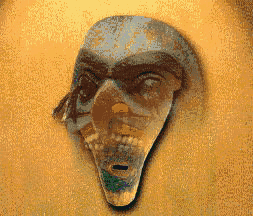Shamans' masks from the Arctic Circle hang in temperature-controlled museums, crystals secreted in crusty fissures. The pulse of drums on which spirits galloped to the Otherworld, are harnessed by bells calling The People to church. Magical flights are flown by bush pilots on featherless wings, and healers, once paid in caribou meat, now bill the government. Yet, rain winds its way down through primeval horizons, rivers rise and fall, trees flare, blacken, and split open, when lightning strikes at the height of lengthening summers, dropping hot seed-cones onto re-fertilized ground. |
 |
In
Spring plants continue to blossom, and for
(Empedocles), we humans are plants: human plants. Actually we
are seeds and have not yet become plants. We have not budded
yet, have not yet started to open and blossom. We have the
potential to become full human beings but the potential has
not been realized. And I find this amazing and terrifying,
that someone 500 years ago–someone who was laying the
foundations for all our philosophical and scientific disciplines–said
we’re not yet human, because glaciers,
shrunk to puddles, will someday display their long blue-white
fissured faces again, and dazzling icebergs rise from the waves
of cooling seas.
|
Pursuing two fishers, chased caught
looked upon with Owl's eyes the two
disappeared, wheeling upstream.Behind the smokehouse traps
seemed to embrace flesh only,
daring not to look see find.Glancing further than from what
his trance was hunting he crossed
the river, and buried his bones.
Caves of Paleolithic Art, asymmetric as an shaman's mask, are stumbled into, high water marks of Modern Art lost beneath fields of chthonic earth central to an understanding of how these social groups that invented anthropology and modern art have appropriated exotic things, facts, and meanings. (Appropriate: 'to make one's own,' from the Latin proprius, 'proper,' 'property.') It is important to analyze how powerful discriminations made at particular moments constitute the general system of objects within which valued artifacts circulate and make sense for forty thousand years. Without loss, there is no discovery and what is discovered, is who we are.